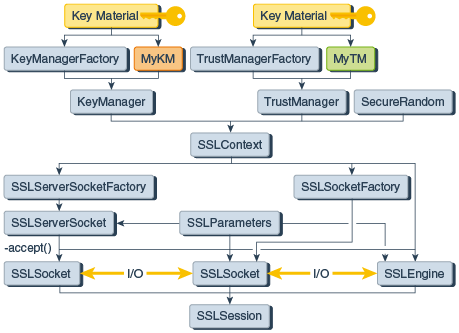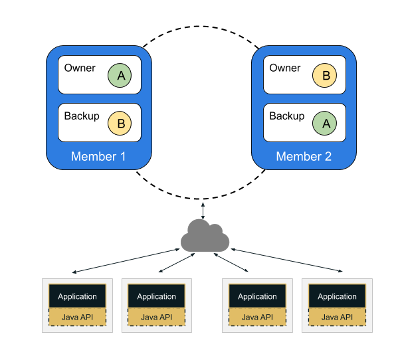layout: true background-image: url(background.png) --- background-image: url(background_deck.png) class: middle # Keep Your Secrets Secret # # TLS for Java developers ??? ### Prepare * terminal - tcpdump * Wireshark - cleanup password * send mail to jsignpdf@gmail.com * cleanup /etc/hosts * set-up pointing device * set-up 2 monitors --- ## Josef Cacek * Security engineer / Java developer at Hazelcast * Father * Runner * Open-source contributor --- background-image: url(background_deck.png) class: middle # Summary --- class: middle, center # I. Choose the protocol and its parameters wisely! --- class: middle, center # II. Measure what it costs you using the TLS. --- class: middle, center # III. Don't forget the checks, # which you don't get for free in Java. --- class: middle, center # Bonus: # Know your tools. --- background-image: url(background_deck.png) class: middle # Demo and Motivation --- ## Demo ### I. Choose the protocol and its parameters wisely! * Protected application running at https://hazelcast-test.cacek.cz/ * attacker captures the communication * they are able to decrypt it, if they get access to the server's private key --- ## Motivation ### II. Measure what it costs you using the TLS. * know the TLS price * what are your preferences? * throughput * latency * CPU load ### Hazelcast performance testing * tool: Hazelcast Simulator *(github.com/hazelcast/hazelcast-simulator)* * test configuration: * 2 servers * 4 clients * TLS enabled in client-to-member communication --- background-image: url(tls-images/report-all.png) ### Plain vs TLS ??? This is a throughput graph - how many Map operations is done per second. * top curves are for plain Hazelcast Client protocol communication * from the middle down they are TLS protected communications * you can see great diversity of performance One half ... to one tenth of the original throughput. --- ## Demo ### III. Don't forget the checks, which you don't get for free in Java. * What can happen if you don't enable hostname validation? * Java Mail API tutorial - https://kodejava.org/how-do-i-receive-mail-using-pop3/ * Receive mails using POP3+TLS * Man in the middle intercepting * with a valid certificate for another hostname ??? * Send a [sample mail](mailto:jsignpdf@gmail.com) -- #### MITM in Raspberry Pi 3 ```bash iptables -A FORWARD -i eth0 -o wlan0 -m state --state RELATED,ESTABLISHED -j ACCEPT iptables -A FORWARD -i wlan0 -o eth0 -j ACCEPT iptables -t nat -A POSTROUTING -o eth0 -j MASQUERADE iptables -t nat -A PREROUTING -i wlan0 -p tcp -m tcp --dport 995 -j REDIRECT --to-ports 8443 sslsplit -S logs -A hazelcast-test.pem ssl 0.0.0.0 8443 tcp 0.0.0.0 8080 ``` ??? Originally the Demo should use this Raspberry Pi as a WiFi hotspot and intercept all the TLS communication on port 995. sslsplit: * in this case serving one certificate to all intercepted requests * there is another mode which uses a custom CA which generates and signs certificates on the fly. The problem is you would need to add the custom CA to your Java keystore to intercept the communication successfuly. We will use a local variant of the demo. ### Run demo ``` vi mitm-995-local.sh ./mitm-995-local.sh ``` Run the program in Eclipse --- background-image: url(tls-images/mitm-pop3-wireshark.png) --- background-image: url(tls-images/pop3_checkserveridentity.png) --- ## Demo ### Bonus: Know your tools * Debug TLS connections ```bash java -Djavax.net.debug=ssl:handshake ... ``` * Dump TCP traffic E.g. HTTPS: ```bash sudo tcpdump -i any -s0 -w https-traffic.pcap 'port 443' ``` * Analyze the capture in WireShark * OpenSSL tool - swiss knife for the TLS ??? OpenSSL - not only library * client * server * ca * OCSP responder * TSA * manipulate certificates and keystores --- background-image: url(background_deck.png) class: middle ## I. Choose the protocol and its parameters wisely! ??? Now will come another round. This time with some recommendations. --- class: middle # Prefer TLS 1.3, when you can. ## Use TLS 1.2 and (EC)DHE key exchange in all other cases. ??? Let's do a small recap. TLSv1.3 is a major rewrite of the specification. ## Transport Layer Security * cryptographic protocol * wraps application protocol to a secure packaging * versions * SSL 2.0, SSL 3.0 *(deprecated in 2011/2015)* * TLS 1.0 (1999)- RFC-2246 *(to be deprecated in 2020)* * TLS 1.1 (2006)- RFC-4346 *(to be deprecated in 2020)* * **TLS 1.2** (2008)- RFC-5246 * **TLS 1.3** (2018)- RFC-8446 TLS builds on the earlier SSL specifications (1994, 1995, 1996) developed by Netscape Communications for adding the HTTPS protocol to their Navigator web browser. * SSL 1.0 Unpublished * SSL 2.0 1995 Deprecated in 2011 (RFC 6176) * SSL 3.0 1996 Deprecated in 2015 (RFC 7568) IETF=The Internet Engineering Task Force (organization behind RFCs) --- ## Forward secrecy .center[ *Feature of key agreement protocols that gives assurances that session keys will not be compromised even if the private key of the server is compromised.* ] * mandatory in TLS 1.3 * choose ciphersuites wisely in older versions * avoid RSA key exchange ??? What we want from our TLS configuration is a **Forward Secrecy** of **Key exchange**. * https://security.stackexchange.com/questions/145855/how-to-enforce-perfect-forward-secrecy-using-jvm-properties * https://stackoverflow.com/questions/14034508/dh-vs-dhe-and-ecdhe-and-perfect-forward-secrecy * https://www.digicert.com/ssl-support/ssl-enabling-perfect-forward-secrecy.htm --- ## Role of Ciphersuites in the TLS ### Ciphersuite * named set of cryptographic primitives * client and server agrees on it * defines how security will be implemented *TLS is a framework, Ciphersuite selects how security will be implemented.* ??? https://www.feistyduck.com/library/bulletproof/online/ch-protocol.html#cipher-suites * TLS allow great flexibility - it's rather a framework for creating cryptographic protocols * A suite is defined roughly by the following attributes: * Authentication method * Key exchange method * Encryption algorithm * Encryption key size * Cipher mode (when applicable) * MAC algorithm (when applicable) * PRF (TLS 1.2) * Hash function used for the Finished message (TLS 1.2) * Length of the verify_data structure (TLS 1.2) -- ### Example E.g. **`"TLS_ECDHE_ECDSA_WITH_AES_256_GCM_SHA384"`** * authentication: `ECDSA` * key exchange: `ECDHE` * cipher (encryption algorithm, key-size, mode): `AES-256-GCM` * pseudorandom function: `SHA-384` --- ### JSSE classes and interfaces .center[  .grey.font80[*Source: https<nolink>://docs.oracle.com/javase/10/security/java-secure-socket-extension-jsse-reference-guide.htm*] ] ??? How can we achieve the Forward Secrecy in java? --- ### SSLContext initialization ```java KeyStore keyStore = KeyStore.getInstance("PKCS12"); KeyStore trustStore = KeyStore.getInstance("PKCS12"); try (InputStream kis = new FileInputStream("keystore.p12"); InputStream tis = new FileInputStream("truststore.p12")) { keyStore.load(kis, password); trustStore.load(tis, "s3crEt".toCharArray()); KeyManagerFactory kmf = KeyManagerFactory.getInstance(KeyManagerFactory.getDefaultAlgorithm()); kmf.init(keyStore, password); TrustManagerFactory tmf = TrustManagerFactory.getInstance(TrustManagerFactory.getDefaultAlgorithm()); tmf.init(trustStore); SSLContext sslContext = SSLContext.getInstance("TLS"); sslContext.init(kmf.getKeyManagers(), tmf.getTrustManagers(), new SecureRandom()); //... getServerSocketFactory, createSSLEngine, ... } ``` --- ## Setting protocols and ciphersuites ```java SSLSocket sslSocket = (SSLSocket) sslContext.getSocketFactory() .createSocket("pop.gmail.com", 995); sslSocket.setEnabledProtocols(new String[] {"TLSv1.2", "TLSv1.3"}); sslSocket.setEnabledCipherSuites(new String[] { "TLS_ECDHE_ECDSA_WITH_AES_256_GCM_SHA384", "TLS_AES_256_GCM_SHA384"}); ``` .pull-right[ **call method** * `String[] getSupportedCipherSuites()` * `String[] getEnabledCipherSuites()` * **`void setEnabledCipherSuites(String[])`** * `String[] getSupportedProtocols()` * `String[] getEnabledProtocols()` * **`void setEnabledProtocols(String[])`** ] .pull-left[ **From class** * `SSLEngine` * `SSLSocket` * `SSLServerSocket` ] --- ## Recommendations for a cipher string * Check OWASP TLS Cipher String Cheat Sheet * https://github.com/OWASP/CheatSheetSeries/blob/master/cheatsheets/TLS_Cipher_String_Cheat_Sheet.md ??? * OWASP Foundation - the free and open software security community Open Web Application Security Project --- background-image: url(background_deck.png) class: middle ## II. Measure what it costs you using the TLS. --- class: middle # Measure! ## Prefer TLS 1.3 and new Java releases. --- ## Full Handshake in TLS 1.2 ```plain Client Server ClientHello --------> ServerHello Certificate* ServerKeyExchange* CertificateRequest* <-------- ServerHelloDone Certificate* ClientKeyExchange CertificateVerify* [ChangeCipherSpec] Finished --------> [ChangeCipherSpec] <-------- Finished Application Data <-------> Application Data ``` --- ## Full Handshake in TLS 1.3 ```plain Client Server Key ^ ClientHello Exch | + key_share* | + signature_algorithms* | + psk_key_exchange_modes* v + pre_shared_key* --------> ServerHello ^ Key + key_share* | Exch + pre_shared_key* v {EncryptedExtensions} ^ Server {CertificateRequest*} v Params {Certificate*} ^ {CertificateVerify*} | Auth {Finished} v <-------- [Application Data*] ^ {Certificate*} Auth | {CertificateVerify*} v {Finished} --------> [Application Data] <-------> [Application Data] ``` --- ## Hazelcast IMDG ```java HazelcastInstance hz = HazelcastClient.newHazelcastClient(); Map<Integer, User> userCache = hz.getMap("users"); User user = userCache.get(id); if (user == null) { user = dbUtil.loadUser(id); userCache.put(id, user); } ``` Goals: * performance * simplicity ??? * Hazelcast IMDG * open-source in-memory data grid * main use-cases - distributed cache which scales * not limited by heap limits or single JVM * TLS as an Enterprise feature --- ## Hazelcast TLS performance tests .pull-right.center[  ] * configuration * `Hazelcast: 2 members + 4 clients` * `Java (Zulu/OpenJDK): 8 v 11 v 13` * `TLS engine: JSSE v BoringSSL` * `TLS protocol: TLSv1.2 v TLSv1.3` * TLS enabled for client-member connections * scenario: `Map` operations executed by clients on cluster members --- background-image: url(tls-images/report-TLSv1.2.png) .font80[ TLS 1.2 Hazelcast `IMap.put 10%` `IMap.get 80%` `IMap.set 10%` ] ??? BoringSSL shines only in Java 8, but its performance dropped when used in newer Java. * 8 BoringSSL * 13 JSSE * 11 JSSE * 13 BoringSSL * 11 BoringSSL * 8 JSSE --- background-image: url(tls-images/report-TLSv1.3.png) .font80[ TLS 1.3 Hazelcast `IMap.put 10%` `IMap.get 80%` `IMap.set 10%` ] ??? OpenJSSE was explicitly enabled TLS1.3 backport in Java. BoringSSL doesn't work with TLS 1.3 in Java 8. * 13 JSSE * 11 JSSE * 13 BoringSSL * 11 BoringSSL * 8 JSSE `-XX:+UseOpenJSSE` --- background-image: url(tls-images/latency.png) ### TLS handshake latencies test ??? * logaritmic scale on latency axis * small differences across ciphersuites * big differences across Java and TLS impl versions --- ## Native TLS libraries - OpenSSL / BoringSSL * available through `netty-tcnative` - https://netty.io/wiki/forked-tomcat-native.html * Maven Dependencies: * `io.netty:netty-handler` * `io.netty:netty-tcnative` *(dynamicallly linked OpenSSL)* * `io.netty:netty-tcnative-boringssl-static` *(statically linked BoringSSL)* -- ```java import io.netty.buffer.UnpooledByteBufAllocator; import io.netty.handler.ssl.SslContext; import io.netty.handler.ssl.SslContextBuilder; import io.netty.handler.ssl.SslProvider; import javax.net.ssl.SSLEngine; SslContext context = SslContextBuilder.forClient() .trustManager(new File("ca.crt")) .sslProvider(SslProvider.OPENSSL) .build(); SSLEngine sslEngine = context.newEngine(UnpooledByteBufAllocator.DEFAULT); ``` ??? Forked Tomcat Native. --- background-image: url(background_deck.png) class: middle ## III. Don't forget the checks, ## which you don't get for free in Java. --- class: middle ## Enable hostname validation. ### Check certificate validity and revocation status when appropriate. --- ## Hostname validation and Server Name Indication * X.509 certificates may contain Subject Alternative Names (SAN) extension * Several RFCs specify how to check hostnames and IP addresses against SAN entries * hostname checking in Java * out-of-the-box: HTTPS and LDAPS client * custom options e in some API (e.g. Java Mail) * manually through `SSLParameters` (`SSLSocket`, `SSLEngine`) ```java SSLParameters params = sslEngine.getSSLParameters(); // Use Server Name Indication params.setServerNames(Arrays.asList(new SNIHostName("www.google.com"))); // Enable hostname validation (available algorithms: LDAPS, HTTPS) params.setEndpointIdentificationAlgorithm("HTTPS"); sslEngine.setSSLParameters(params); ``` ??? RFCs: * HTTP-TLS 2818 * LDAP-TLS 2830 * General 6125 --- ## Certificate status * revocation checks can be enabled by Security and System properties * CRL DP * OCSP * OCSP stapling * validity is not checked for self-signed certificates * manual check: `((X509Certificate) certificate).checkValidity()` --- background-image: url(tls-images/cert_validity_checking.png) --- background-image: url(background_deck.png) class: middle ## Bonus: Know your tools --- class: middle # Prefer PKCS12 over JKS / JCEKS. ## Automate certificates --- ## Keystore types * PKCS12 * open standard format and algorithms * keystore default type from Java 9 * JKS and JCEKS * proprietary * implementations are not compatible accross vendors * Security evaluation of Java Keystores: * https://minimalblue.com/data/papers/NDSS2018_mind_your_keys.pdf --- ## Let's Encrypt, certbot & ACME * Let's Encrypt - Free Certificate Authority (CA) * ACME - Automatic Certificate Management Environment * `certbot` - ACME protocol client **Java integration** ```bash DOMAIN=java2days.cacek.cz # Obtain Certificate from Let's Encrypt CA certbot certonly --standalone -d $DOMAIN # Import private key and certificates to a keystore openssl pkcs12 -export -out /opt/keystore-$DOMAIN.p12 \ -in /etc/letsencrypt/live/$DOMAIN/fullchain.pem \ -inkey /etc/letsencrypt/live/$DOMAIN/privkey.pem \ -password pass:pass.123 ``` ??? * PoC integration embedded Jetty + with ACME client from WildFly AS * in 1 day * https://github.com/wildfly-security/wildfly-elytron/tree/1.10.4.Final/x500/cert/acme --- class: center, middle background-image: url(star-wars-sword.png) # Use .red[Transport Layer Security], Luke, # # # and pick wisely. --- class: center, middle # .font200[Thank you] .grey.font150.center[ `github.com/kwart` `twitter.com/jckwart` `javlog.cacek.cz` ]